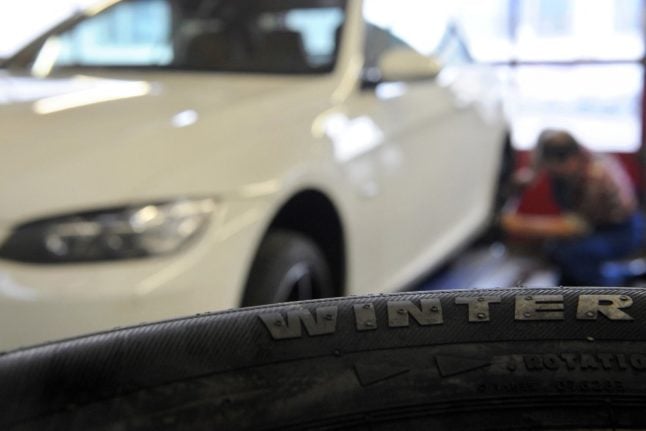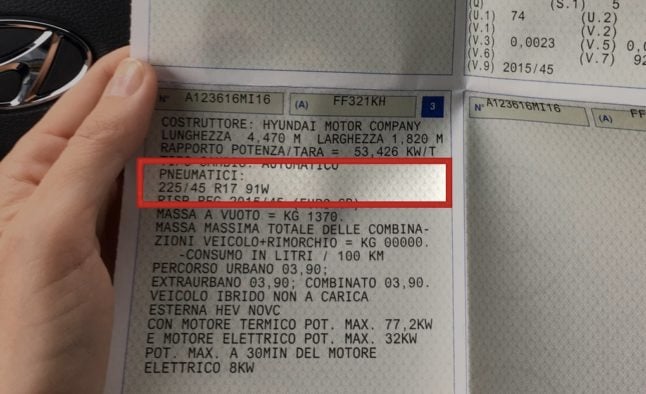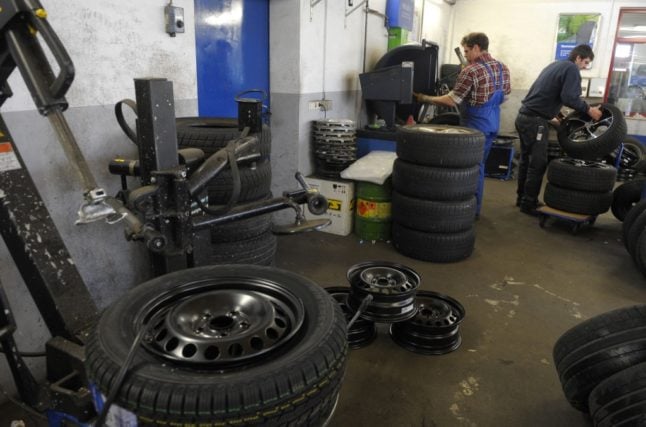EXPLAINED: Do you need to switch your tyres for summer in Italy?

Italy's road rules require a switch from winter to summer tyres by May 15th - but who exactly does this rule apply to? Here’s what you need to know.
Though we may not have seen much in the way of sunny weather and balmy temperatures lately, the warm season appears to be just around the corner. And for many motorists in Italy this means a requirement to change their tyres.
Unusually, Italian road rules have since 2014 included a ban on the use of winter tyres during the summer months - specifically from May 15th onwards, though the window for making the switch starts on April 15th.
Breaking this rule can be expensive, potentially resulting in a fine of up to 1,731 euros plus the requirement to undergo a revisione (the Italian equivalent of a UK MOT test or a vehicle inspection in the US).
But the rules are a frequent source of confusion, as they don’t apply to everyone.
Here’s a detailed look at who is actually required to make the switch from winter to summer tyres in Italy, and how to find out whether or not the requirement applies to you.
Who do the rules apply to?
In typically Italian fashion, rules on summer tyres are fairly convoluted but they can be summarised as follows.
The legal requirement to switch to summer tyres by May 15th only applies to vehicles whose winter tyres – these are generally marked with ‘M+S’ (‘mud plus snow’) or with a snowflake encircled by a three-peak mountain range – have a speed rating which is lower than the tyre speed rating indicated on their registration certificate (carta di circolazione).

Not all motorists in Italy have to make the switch from winter to summer tyres. Photo by Christof STACHE / AFP
This means that, if the winter tyres on your car have a speed rating which is higher than or equal to the speed rating shown in the car’s registration certificate, you won’t have to make the switch.
Furthermore, the summer tyres requirement does not apply to vehicles fitted with all-season tyres (pneumatici quattro stagioni) – these are generally marked with ‘4S’ (standing for ‘4 Seasons’).
Where can I find the relevant speed ratings?
A tyre speed rating indicates the fastest speed a tyre can handle before it no longer performs as designed, and it is expressed as an alphabet letter from A (lowest) to Y (highest).
All tyre speed ratings and their corresponding letters are available at the following link.
READ ALSO: How do you dispute a parking ticket in Italy?
The speed rating of a tyre can generally be found on its sidewall, right after the load rating (a two- or three-figure number expressing the maximum weight a tyre is able to carry).
So, for instance, a tyre carrying the letter ‘N’ on its sidewall has a speed rating of 140 kilometres an hour (or 87 mph).
As for your car registration certificate, the tyre speed rating can usually be found below the ‘PNEUMATICI’ (tyres) heading in the bottom-left quadrant of the document.
Once again, the rating will be expressed as a letter from A to Y and will figure right after the load rating, as shown by the picture below.

Photo by Sir Car Ferrara
Practical examples
If the winter tyres on your car carry a Q rating (160 km/h), but your registration certificate says that, in normal conditions (i.e. outside of the cold season), your tyres should have an S rating (180 km/h), you’ll be legally required to switch to summer tyres.
If the winter tyres on your car carry a T rating (190 km/h) and your registration certificate says that, in normal conditions, your tyres should have an S rating (180 km/h), you won’t be required to switch to summer tyres.
I’m not legally required to switch to summer tyres. Should I do it anyway?
Though you may not be legally required to switch to summer tyres, having summer tyres on during the warm (and hot) months is advisable.
In fact, with temperatures above 7C, summer tyres allow for better grip and braking and less fuel consumption compared to their winter counterparts.
READ ALSO: How to avoid car hire scams in Italy
In the words of Fabio Bertolotti, director of Italian tyre association Assogomma, motorists are always advised to use tyres suited to the season they’re in “not just to abide by the relevant laws but, above all, to have a vehicle capable of offering the best possible performances in any weather condition”.
How much does switching to summer tyres cost?
If you already own a set of summer tyres, you’ll only have to pay for fitting, with prices generally ranging from 30 to 70 euros.
But, should you have to buy a new set, a mid-range set of summer tyres will set you back around 300 euros (that’s 70-75 euros per tyre).

A new set of mid-range summer tyres will generally set you back around 300 euros. Photo by Christof STACHE / AFP
What are the rules for motorcycles?
Motorcycles aren’t subject to winter tyres rules, meaning owners are not legally required to have winter tyres on during the cold months.
But, if you fitted your motorcycle with winter tyres last year, then you’ll have to switch to summer ones unless the speed rating provision mentioned earlier for cars applies.
Note that the Italian Highway Code gives regions and individual provinces the power to alter national rules based on differing features and climate in each area, meaning that, in some parts of the country, the summer tyre deadline may be different from the national one on May 15th. You can check this year’s dates for your own comune with your local Motorizzazione Civile office.
Please note that The Local cannot advise on individual cases. For more information, get in touch with your Motorizzazione Civile office or seek the advice of a professional.
Comments
See Also
Though we may not have seen much in the way of sunny weather and balmy temperatures lately, the warm season appears to be just around the corner. And for many motorists in Italy this means a requirement to change their tyres.
Unusually, Italian road rules have since 2014 included a ban on the use of winter tyres during the summer months - specifically from May 15th onwards, though the window for making the switch starts on April 15th.
Breaking this rule can be expensive, potentially resulting in a fine of up to 1,731 euros plus the requirement to undergo a revisione (the Italian equivalent of a UK MOT test or a vehicle inspection in the US).
But the rules are a frequent source of confusion, as they don’t apply to everyone.
Here’s a detailed look at who is actually required to make the switch from winter to summer tyres in Italy, and how to find out whether or not the requirement applies to you.
Who do the rules apply to?
In typically Italian fashion, rules on summer tyres are fairly convoluted but they can be summarised as follows.
The legal requirement to switch to summer tyres by May 15th only applies to vehicles whose winter tyres – these are generally marked with ‘M+S’ (‘mud plus snow’) or with a snowflake encircled by a three-peak mountain range – have a speed rating which is lower than the tyre speed rating indicated on their registration certificate (carta di circolazione).

This means that, if the winter tyres on your car have a speed rating which is higher than or equal to the speed rating shown in the car’s registration certificate, you won’t have to make the switch.
Furthermore, the summer tyres requirement does not apply to vehicles fitted with all-season tyres (pneumatici quattro stagioni) – these are generally marked with ‘4S’ (standing for ‘4 Seasons’).
Where can I find the relevant speed ratings?
A tyre speed rating indicates the fastest speed a tyre can handle before it no longer performs as designed, and it is expressed as an alphabet letter from A (lowest) to Y (highest).
All tyre speed ratings and their corresponding letters are available at the following link.
READ ALSO: How do you dispute a parking ticket in Italy?
The speed rating of a tyre can generally be found on its sidewall, right after the load rating (a two- or three-figure number expressing the maximum weight a tyre is able to carry).
So, for instance, a tyre carrying the letter ‘N’ on its sidewall has a speed rating of 140 kilometres an hour (or 87 mph).
As for your car registration certificate, the tyre speed rating can usually be found below the ‘PNEUMATICI’ (tyres) heading in the bottom-left quadrant of the document.
Once again, the rating will be expressed as a letter from A to Y and will figure right after the load rating, as shown by the picture below.

Practical examples
If the winter tyres on your car carry a Q rating (160 km/h), but your registration certificate says that, in normal conditions (i.e. outside of the cold season), your tyres should have an S rating (180 km/h), you’ll be legally required to switch to summer tyres.
If the winter tyres on your car carry a T rating (190 km/h) and your registration certificate says that, in normal conditions, your tyres should have an S rating (180 km/h), you won’t be required to switch to summer tyres.
I’m not legally required to switch to summer tyres. Should I do it anyway?
Though you may not be legally required to switch to summer tyres, having summer tyres on during the warm (and hot) months is advisable.
In fact, with temperatures above 7C, summer tyres allow for better grip and braking and less fuel consumption compared to their winter counterparts.
READ ALSO: How to avoid car hire scams in Italy
In the words of Fabio Bertolotti, director of Italian tyre association Assogomma, motorists are always advised to use tyres suited to the season they’re in “not just to abide by the relevant laws but, above all, to have a vehicle capable of offering the best possible performances in any weather condition”.
How much does switching to summer tyres cost?
If you already own a set of summer tyres, you’ll only have to pay for fitting, with prices generally ranging from 30 to 70 euros.
But, should you have to buy a new set, a mid-range set of summer tyres will set you back around 300 euros (that’s 70-75 euros per tyre).

What are the rules for motorcycles?
Motorcycles aren’t subject to winter tyres rules, meaning owners are not legally required to have winter tyres on during the cold months.
But, if you fitted your motorcycle with winter tyres last year, then you’ll have to switch to summer ones unless the speed rating provision mentioned earlier for cars applies.
Note that the Italian Highway Code gives regions and individual provinces the power to alter national rules based on differing features and climate in each area, meaning that, in some parts of the country, the summer tyre deadline may be different from the national one on May 15th. You can check this year’s dates for your own comune with your local Motorizzazione Civile office.
Please note that The Local cannot advise on individual cases. For more information, get in touch with your Motorizzazione Civile office or seek the advice of a professional.
Join the conversation in our comments section below. Share your own views and experience and if you have a question or suggestion for our journalists then email us at [email protected].
Please keep comments civil, constructive and on topic – and make sure to read our terms of use before getting involved.
Please log in here to leave a comment.